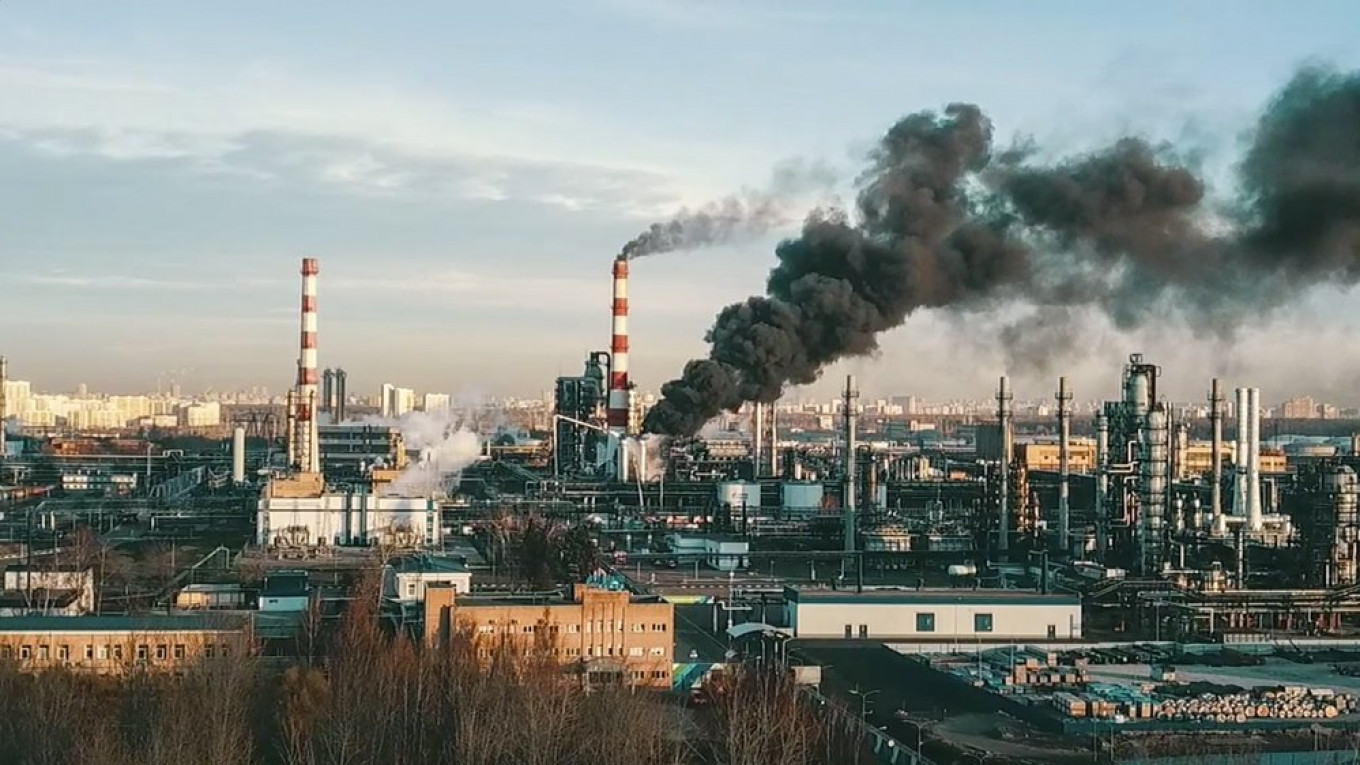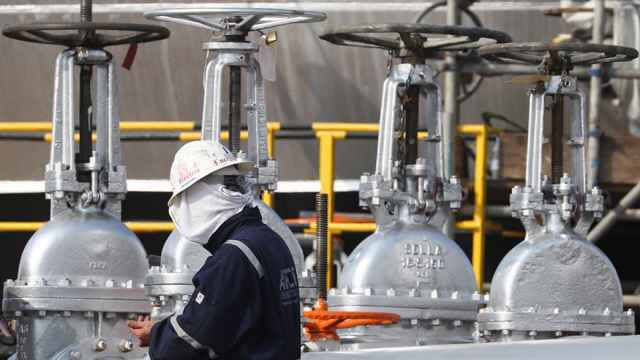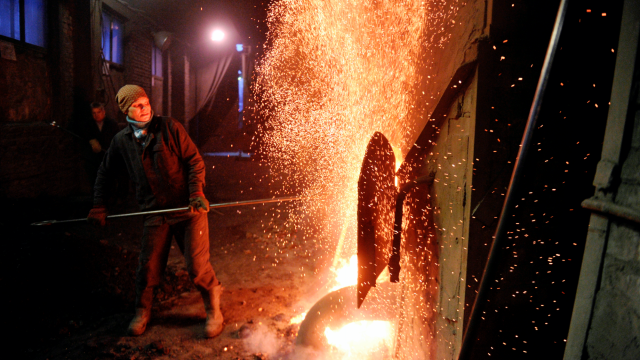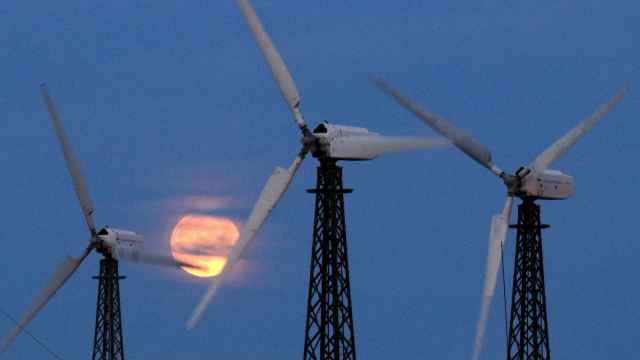Russia ratified the Paris climate accord on September 23, committing itself to reducing carbon dioxide emissions to 70% of the 1990 level.
But that is an easy goal as Russia’s emissions peaked in the last year of the Soviet Union, and the following year emissions collapsed along with the Soviet economy.
Russia’s commitment means it can actually increase its emissions from the current 1.8 gigatonnes a year and still meet its commitments to the Paris deal.
Russia is the world’s fourth-largest polluter. With a territory that stretched half-way around the globe, the Soviet government acted as if the country’s ecology was an infinite resource. But now, global warming has caught up even with Russia, which has suffered from extreme storms and raging forest fires across a territory larger than Europe each summer in recent years.
Moreover, the vast permafrost territory has been warming up. The ground is slowly melting with soil temperatures rising by about one degree per decade. Currently the temperature of the frozen taiga is minus three degrees.
When it melts completely — in about 30 years on current trends — there will be a one-time release of the millions of tonnes of carbon dioxide which are trapped in the ground. Although it is not clear what will happen, the irreversible release of so much carbon dioxide into the atmosphere could have a cataclysmic effect on the environment.
In the meantime, the retreat of the ice caps has already opened up the northern shipping route across the top of the country, cutting weeks off the transit time between Europe and Asia, as well as exposing land in the Arctic that hasn't seen the light of day in millennia and is now being explored for oil deposits.
Cleaning up Russia’s act
The Kremlin has effectively done an about-face on climate change. Until recently, President Vladimir Putin had pooh-poohed the idea and the government did little to deal with its emissions problem.
The Kremlin changed its mind for two reasons.
The first is that environmental issues, in particular the total lack of waste management, have led to large protests in Russia’s far-flung regions.
Secondly, with climate politics creeping up the global agenda, and as Russia is such a large player in geographical terms, the Kremlin has seen an opening to increase its international clout on the world stage. The fact that the U.S. has put itself on the wrong side of this story by withdrawing from the Paris Accord probably helped.
At the same time, there is a fundamental change in thinking among Russia’s biggest and dirtiest companies. The rise of environmental, social and governance (ESG) rankings is starting to hit companies in the pocket.
Some of Russia’s largest raw material producers reported that they have lost up to a third of their equity investors in the last year as fund managers are now demanding not only that companies produce strong profits, but also that they have a sustainable business model which includes ESG factors.
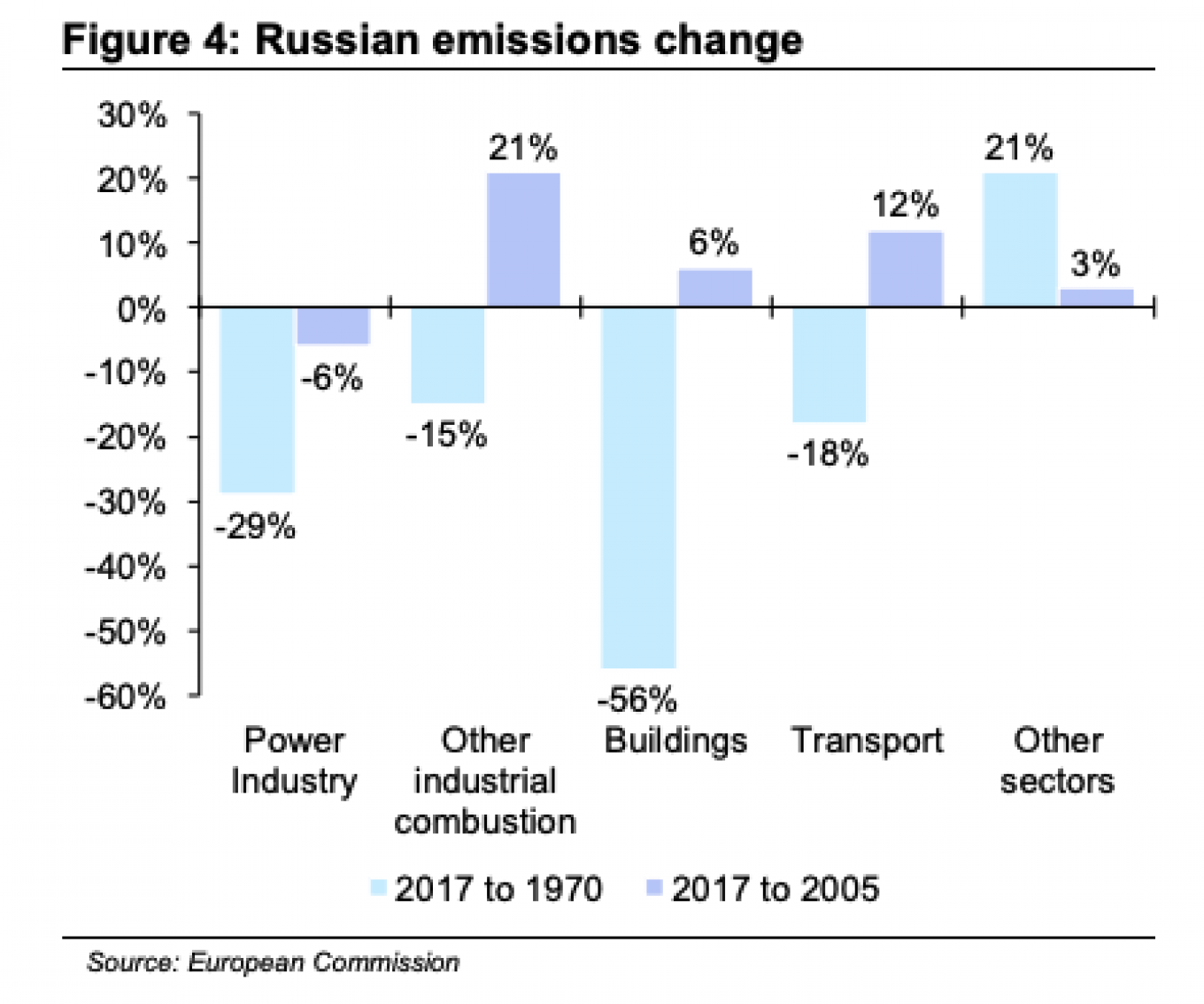
While funds are currently imposing ESG rules on a voluntary basis, many fund managers assume these rules will become mandatory before too long and are adjusting their portfolios early to avoid being forced to sell and take big losses when the fixed regulations eventually come in.
In Moscow, there is currently a noticeable scramble going on among bluechip companies to bring their ESG performance up to par – and that often means literally cleaning up their act and reducing emissions.
Changing the rules
The ratification of the Paris accord is only the first step in a legislative process that should fundamentally transform Russia’s attitude to the environment as well as change its economy.
Under discussion is a new federal law on emissions that will set the landscape for emissions quotas and carbon pricing. There is also the National Climate Plan to establish a legal target for the reduction of carbon dioxide emissions in Russia, as well as a federal fund to support emissions reductions.
It is probable that climate change investments will also be used as another tool for regional development and to build more growth-boosting infrastructure.
“At this moment in time, all of these initiatives are at the discussion phase and so have not been included into our models,” said VTB Capital (VTBC) analysts Vladimir Sklyar and Anastasia Tikhonova in a report on the Paris accord changes.
“However, the key takeaway from this movement is clear: the cost of emissions in Russia is set to rise and it is only the pace of the rise that has yet to be defined.”
The draft law currently under discussion and introduced by the Ministry for Economic Development sets out two phases for its implementation.
The first, within 180 days of its adoption, introduces mandatory carbon dioxide emissions reporting for so-called regulated entities with more than 150,000 tonnes of emissions per year, detailed government monitoring of emissions by sector and company, the publication of collected data for public access, and mandatory auditing of any carbon footprint reports by authorised agents, reports VTBC.
The second phase, to be carried out within five years of the law being adopted, envisages the introduction of carbon dioxide quotas and targets for regulated entities, support and verification of the emissions-reduction investment projects, which would be awarded carbon quotas for resale, a system of carbon quota trading, and penalties for exceeding emissions quotas.
At the corporate level change could come even faster, as portfolio investors selling off their shares have already burnt companies. For instance, Norilsk Nickel has already spent $2 billion on its emissions clean-up programme, despite the fact that spending adds nothing to the company’s profitability.
National Climate Plan
The details of just how Russia will reduce emissions will be the substance of its National Climate Plan (NCP), which is due to be published sometime in October and will set the targets that can then be detailed in law and regional strategies.
The key detail — by just how much Russia will reduce its carbon footprint — remains a matter of debate. The Paris Accords suggest that countries cut emissions by 30% from 2005 levels.
Russia emitted 1,734 million tonnes of carbon dioxide in 2005. However, the Kremlin has set 1990 as its benchmark, when Russia emitted 2,397 million tonnes - a figure 38% higher than the Paris recommendations and significantly more than what Russia is emitting today.
A 30% reduction from the 1990 level would allow Russia to produce 1,678 million tonnes of carbon dioxide a year — only 5% less than the 1,765 million tonnes produced in 2017.
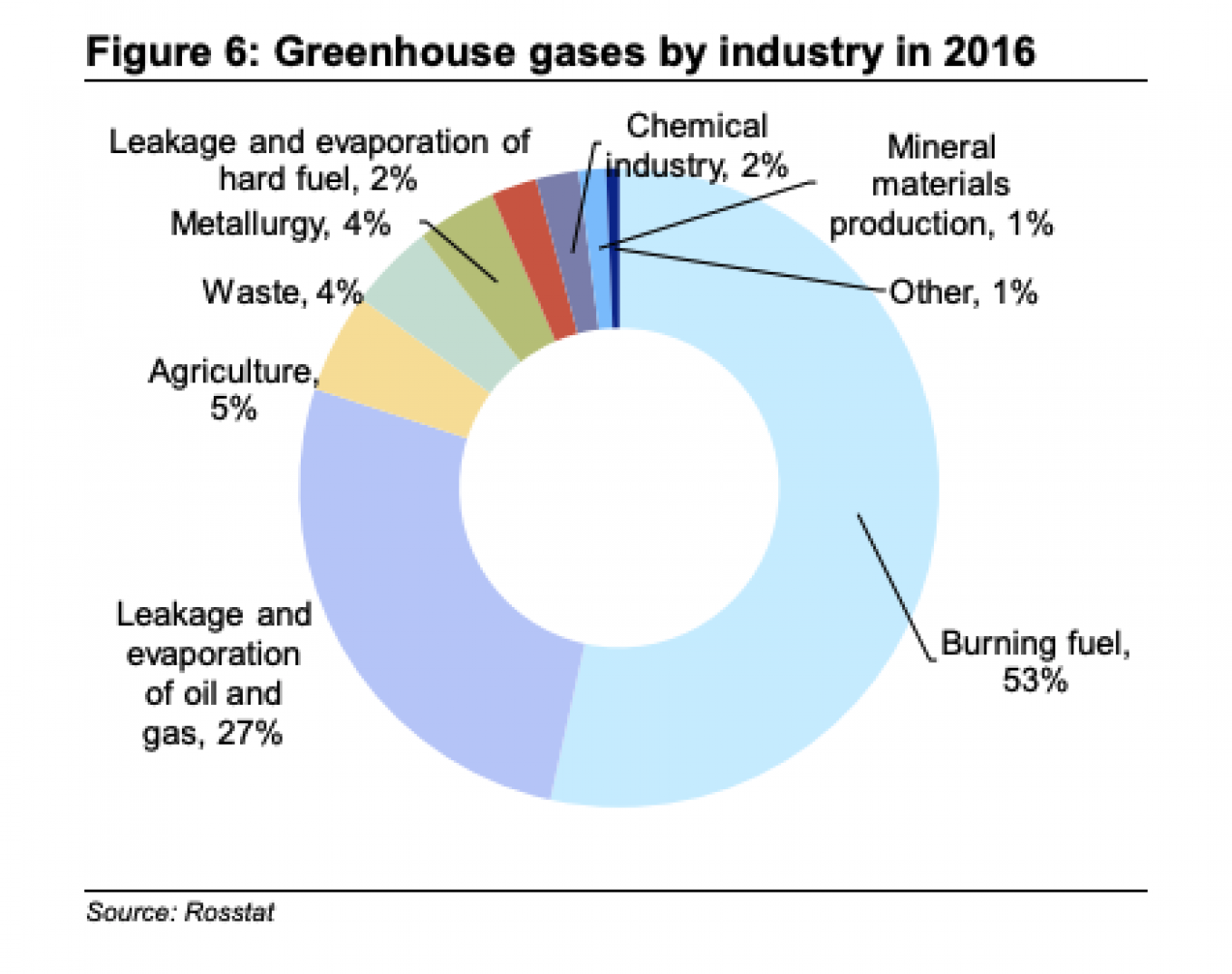
However, if 2005 was set as the benchmark year, then Russia would have to reduce its emissions by a third from current levels — a hefty 550 million tonnes per year.
“Russia is the world’s fourth largest polluter, contributing as much as 1.8 gigatons of carbon dioxide annually,” VTBC said in its report. “Although this is a significant 26% reduction from the 1990 peak, it is a level that has shown resilience over the last 15 years, and is still above the self-imposed target of a 30% reduction. Russia currently emits 74% of the 1990 level and 101% of the 2005 level.”
However, Russia’s vast forests - accounting for 25 per cent of the world’s entire forest resources - help it offset some of its carbon emissions, absorbing around 36% of annual emissions. How this offset will be used in the calculations to determine Russia’s carbon reduction goals is the subject of ongoing debate.
And while carbon dioxide gets the most attention, the Paris deal actually covers a family of gases that are emitted that produce the so-called greenhouse effect on the planet. Collectively known as greenhouse gases, these include methane, nitrous oxide, hydrofluorocarbons, perfluorocarbons, sulfur hexafluoride and nitrous trifluoride among others.
This list means reduction targets will hit several important Russian industries, in addition to those simply burning fossil fuels to produce power. For instance, the oil and metals industries produce a lot of sulphur, and animal husbandry is a huge producer of methane - a problem at a time when Russia is trying to become self sufficient in beef.
According to Russian statistics, the country’s total net greenhouse gas emissions, measured in carbon dioxide equivalent, were 2,009 million tonnes in 2016. Russia’s gross emissions of 2,644 million tonnes were offset by the 635 million tonne intake from forests and land use. Just over half (53%) of emissions came from burning fuel, 27% from the leakage and evaporation of oil and gas, 5% from agriculture and 4% each from waste and metallurgy.
However, Russia has not been sitting on its hands, and already has fairly extensive, if somewhat ad hoc, legislation to regulate environmental issues.
Legally-binding instruments aimed at limiting greenhouse gas emissions to at most 75% of 1990 levels by the end of next year were enacted by presidential decree in September 2013 and a follow-up law in April 2014. These two acts enable greenhouse gas emissions forecasting at the economy-wide scale and for individual sectors. But the existing legislation needs to be fleshed out and expanded if it is to have any real impact on emissions.
What is remarkable is that so far Russia enjoyed very rapid economic growth without a corresponding growth in greenhouse gas production. During the boom years of 2000 to 2012 the economy increased in size by 173%, but the emissions of greenhouse gases only increased by 112%.
Russia’s forests give it a huge advantage in hitting emissions targets and, in theory, Russia has to do little beyond manage its forests properly, reduce energy intensity in industry and increase the use of renewables in the energy mix to grow its economy with minimal increases in greenhouse gas emissions.
Where’s it coming from?
On a sectoral level, utilities is the single biggest emitter, accounting for just under half (47%) of all emissions, against the global average of 37%, according to VTBC. That’s partly due to Russia’s abundant supplies of natural gas, which is burnt to produce electricity.
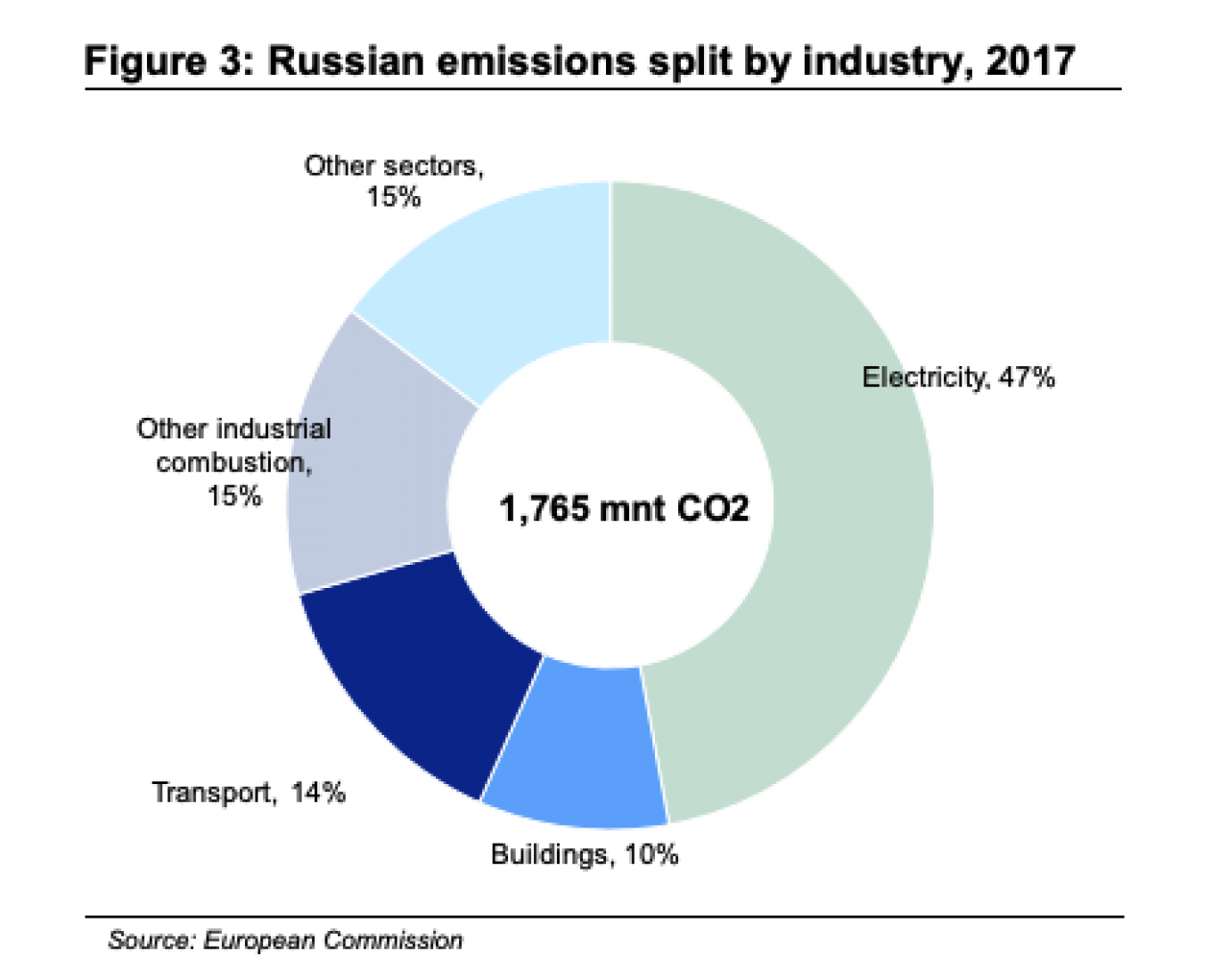
Here too there has been progress, albeit driven by a desire to reduce costs rather than fix the environment, as carbon dioxide emissions are actually down by a third (30%) in the power sector from 1970 levels, VTBC reports.
Another two big sources of emissions are buildings (10%) and transport (14%). Buildings are especially bad in Russia as a large part of the housing stock was built following the destruction of WWII and thanks to the cold weather these houses have centrally-organised central heating, where residents have no control over the heat.
But here too there have been improvements, as residential real estate development has boomed in recent years and newer buildings are much more efficient than old Soviet blocks. Emissions from housing have actually fallen by 56% from their 1970 levels, and analysts expect this trend to continue, quite apart from the Paris Accords, as the Soviet housing stock continues to be replaced.
This article first appeared in bne IntelliNews.
A Message from The Moscow Times:
Dear readers,
We are facing unprecedented challenges. Russia's Prosecutor General's Office has designated The Moscow Times as an "undesirable" organization, criminalizing our work and putting our staff at risk of prosecution. This follows our earlier unjust labeling as a "foreign agent."
These actions are direct attempts to silence independent journalism in Russia. The authorities claim our work "discredits the decisions of the Russian leadership." We see things differently: we strive to provide accurate, unbiased reporting on Russia.
We, the journalists of The Moscow Times, refuse to be silenced. But to continue our work, we need your help.
Your support, no matter how small, makes a world of difference. If you can, please support us monthly starting from just $2. It's quick to set up, and every contribution makes a significant impact.
By supporting The Moscow Times, you're defending open, independent journalism in the face of repression. Thank you for standing with us.
Remind me later.



